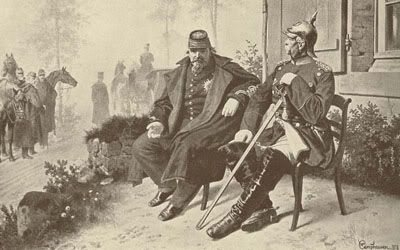Otto von Bismarck agrees to a cease-fire with the Allies. At exactly Noon, the guns fall silent for the first time in almost half a year. In Berlin, people mourn at this news. Veterans of the Napoleonic Wars are heard muttering things such as "...It's happening again..."
Meanwhile, in Paris and Vienna, there is much rejoicing. People crowd the streets shouting and firing guns into the air.
November 15, 1870
Otto von Bismarck and a host of other delegates arrive in Liechtenstein to discuss peace terms. The "Iron Chancellor" is in a horrible state. His clothes are unwashed, he is unshaven, and it looks like he hasn't eaten in days.
Napoleon III on the other hand, looks quite the opposite. He has slept better than he ever has through the course of the past few days.
The Peace negotiations begin at once.
November 30, 1870
After two weeks of deliberations, a rough draft of a treaty is ready to be wired to Berlin. If King William I approves of it, the treaty will be fleshed out and signed.

Bismarck and Napoleon Discuss Peace Outside of Vaduz.
December 1, 1870
King William I approves of the treaty. Chancellor Bismarck sees his last chance of a reasonable peace fly out the window.
December 10, 1870
The final draft of the Treaty of Liechtenstein is signed. It entails three main parts:
1) Prussian Wrongs
This part describes the wrongs that Prussia has bestowed upon the rest of Germany, Austria, and France. These include, unjust treatment of German states at the conclusion of the Six Week War in 1866, Blocking of French purchase of Luxembourg, and annexation of the rightfuly independant state of Hanover.
2) Prussian Cessions
The second part of the treaty describes what Prussia, as the losing party, has to give the winning powers. This includes the Saarland to France, Silesia to Austria, and land taken in 1866 back to Saxony. Prussia's allies, Baden and Wurtemberg are formaly annexed into Bavaria. Also, Prussia has to pay a sum of 1 Billions of Francs to both France and Austria.
3) Limits
This part describes the limits to be placed onto Prussia until both France and Austria see it right. This includes an army of more than 150,000 men, no artillery larger than 90mm, and no navy. The Rhineland and an area stretching from the new Austrian border that is 250 miles deep are to be de-militarized.
A depressed Chancellor Bismarck signed the treaty; he had no other choice.
Shortly afterwards, at around midnight, the great "Iron Chancellor" committed suicide.
December 11, 1870
King of Ludwig of Bavaria proposes a merging of his kingdom and that of Saxony. After some deliberations, the King of Saxony agrees. The Kingdom of Saxe-Bavaria is created.

The Flag of Saxe-Bavaria
And with that, the Franco-German War, ended.
To Be Continued...
No comments:
Post a Comment